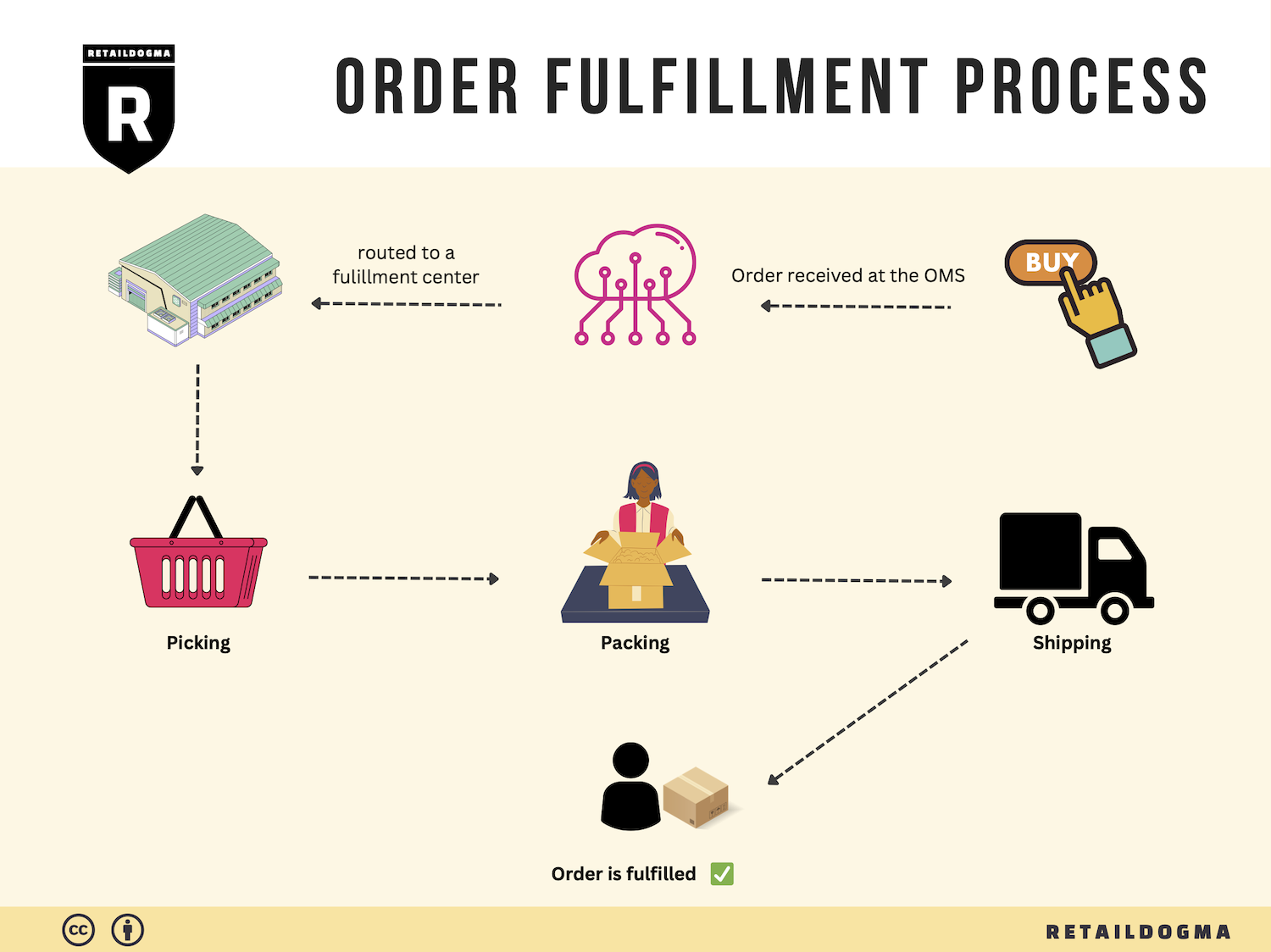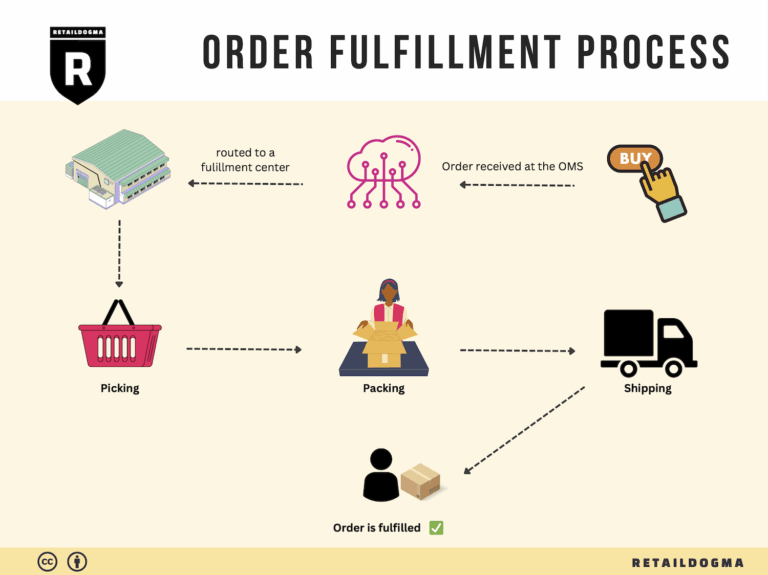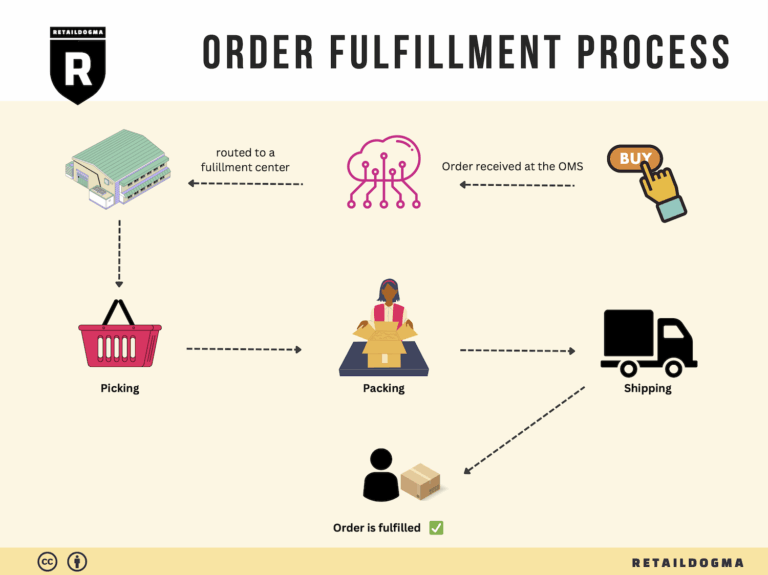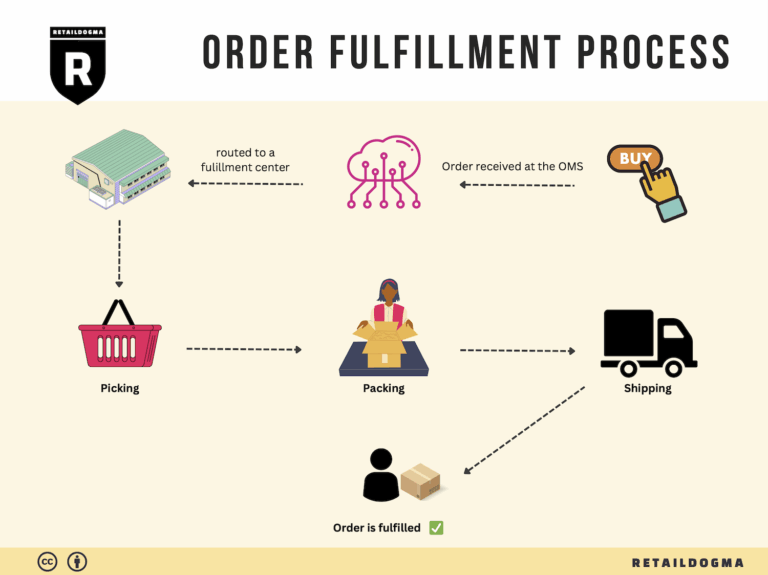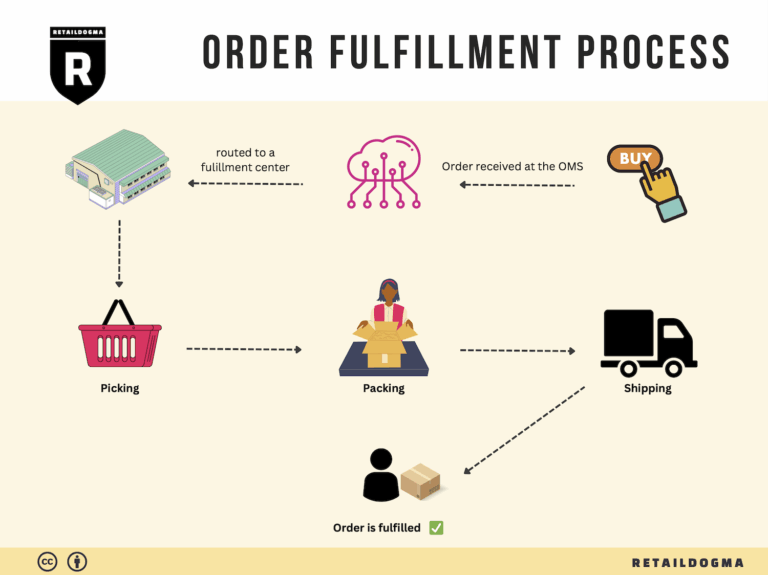How Order Fulfillment Works: A Step-by-Step Guide for Businesses
What is E-commerce Fulfillment? An Introduction for Growing Businesses
Understanding the Challenges of E-commerce Fulfillment
As an e-commerce business owner, you may find yourself grappling with the overwhelming demands of packing and shipping orders. This critical aspect of your operations can quickly become a bottleneck, diverting your focus from growing your business. Whether you’re just starting out or experiencing rapid growth, mastering the fulfillment process is essential to ensure customer satisfaction and maintain operational efficiency.
At its core, fulfillment is simply the process of getting a product from your warehouse (or supplier) to the customer’s doorstep. This involves several steps, including receiving orders, picking and packing items, and managing shipping logistics. As your order volume increases, so does the complexity of these tasks, which can lead to mistakes, delays, and frustrated customers if not managed properly.
In this guide, we will explore the various models of e-commerce fulfillment available to growing businesses. You will learn about options like third-party logistics (3PL) providers, Fulfillment by Amazon (FBA), and self-fulfillment strategies. Each model has its own set of advantages and challenges, and understanding these can help you make an informed decision about which path to take.
We’ll also delve into the core services that fulfillment providers offer, including warehousing, inventory management, order processing, and returns handling. These components are crucial in creating a seamless experience for your customers and ensuring your business runs smoothly.
Choosing the right fulfillment partner can be a daunting task, but it is vital for your business’s success. This guide will provide insights into what to look for in a fulfillment partner, including scalability, technology integration, and cost considerations. You’ll learn how to assess potential partners based on their capabilities and how they align with your business needs.
Finally, we will discuss pricing structures commonly used in fulfillment services, helping you to navigate the costs associated with outsourcing your logistics. Understanding these costs will empower you to find a balance between quality service and maintaining healthy profit margins.
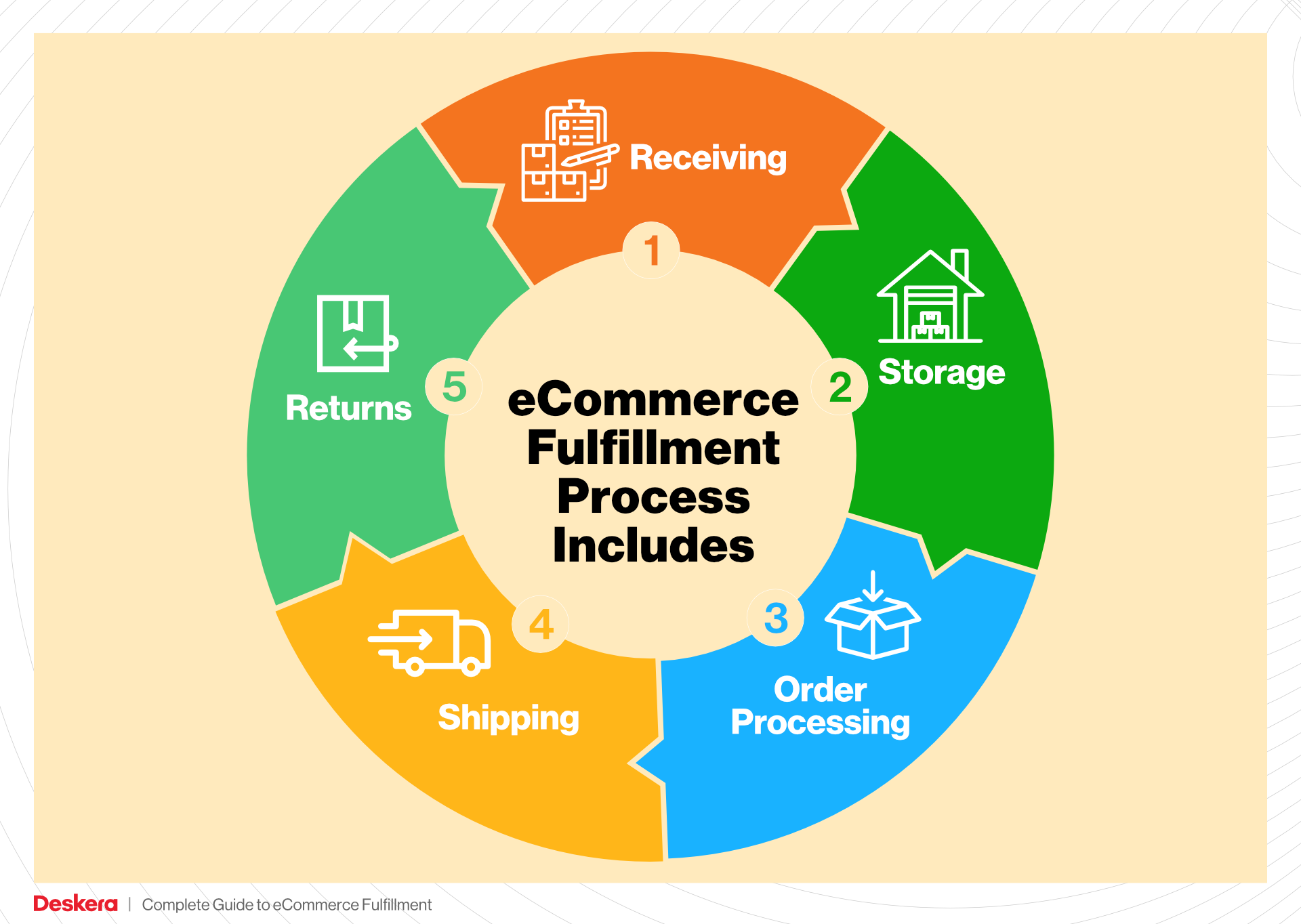
The goal of this guide is to equip you with the knowledge and tools necessary to make smart decisions about your logistics. By optimizing your fulfillment strategy, you can enhance customer satisfaction, streamline operations, and ultimately scale your business more effectively. Let’s dive in and transform your fulfillment process into a competitive advantage.
What You’ll Learn In This Guide
- What is E-commerce Fulfillment? An Introduction for Growing Businesses
- The Order Fulfillment Process: From ‘Buy’ Button to Customer’s Door
- Comparing Fulfillment Models: In-House vs. 3PL vs. Dropshipping
- A Deep Dive into Amazon FBA: Pros, Cons, and Who It’s For
- Core Services Offered by Fulfillment Centers
- How to Choose a Fulfillment Partner: A 6-Point Checklist
- Understanding Fulfillment Pricing: A Breakdown of Common Fees
- Frequently Asked Questions (FAQs) about Fulfillment
- Conclusion: Is Outsourcing Fulfillment the Right Move for Your Business?
- Important Disclaimer
The Order Fulfillment Process: From ‘Buy’ Button to Customer’s Door
1. Receiving Inventory
The order fulfillment process begins with receiving inventory, a critical step that sets the foundation for effective order management. When products arrive at your warehouse, they need to be checked against purchase orders to ensure accuracy in quantities and specifications. This step involves inspecting the items for damage and confirming that they meet quality standards.
Why It’s Important: Proper inventory receiving minimizes discrepancies and ensures you have the correct stock available for customer orders. This step is vital to maintaining accurate inventory levels, which helps prevent stockouts or overstock situations.
Key Term: SKU (Stock Keeping Unit) – A unique identifier assigned to each product, which helps streamline the inventory tracking process. By utilizing SKUs, you can quickly locate and manage your inventory, enhancing overall operational efficiency.
2. Warehouse Storage
Once the inventory is received and verified, it is then moved to warehouse storage. This step involves organizing products in a systematic manner within the warehouse. Efficient storage solutions, such as shelving and pallet racking, should be utilized to maximize space and facilitate easier access to items.
Why It’s Important: Effective warehouse storage reduces the time spent locating products, which can significantly impact order processing speed. Additionally, a well-organized warehouse minimizes the risk of damage and loss, contributing to better inventory management.

Key Term: FIFO (First In, First Out) – An inventory management method that ensures older stock is sold before newer stock. This practice is particularly important for perishable goods but can also help avoid obsolescence in other product categories.
3. Order Picking
The next step in the fulfillment process is order picking, where warehouse staff retrieve products from storage based on customer orders. This can be done using various methods, such as single order picking (picking one order at a time) or batch picking (picking multiple orders simultaneously). Utilizing technology like barcode scanners can enhance accuracy during this stage.
Why It’s Important: Efficient order picking is crucial for timely order fulfillment. The faster and more accurately products are picked, the quicker they can be packed and shipped to customers, ultimately improving customer satisfaction.
Key Term: Pick Lists – Documents or digital tools that provide a list of items to be picked for a specific order. These lists often include SKUs and quantities, enabling warehouse staff to streamline the picking process.
4. Order Packing
After the items have been picked, they move on to order packing. During this stage, products are carefully packed into boxes or envelopes. Proper packing techniques are essential to ensure that items arrive at their destination without damage. This may involve using protective materials like bubble wrap or packing peanuts, as well as selecting the appropriate box size.
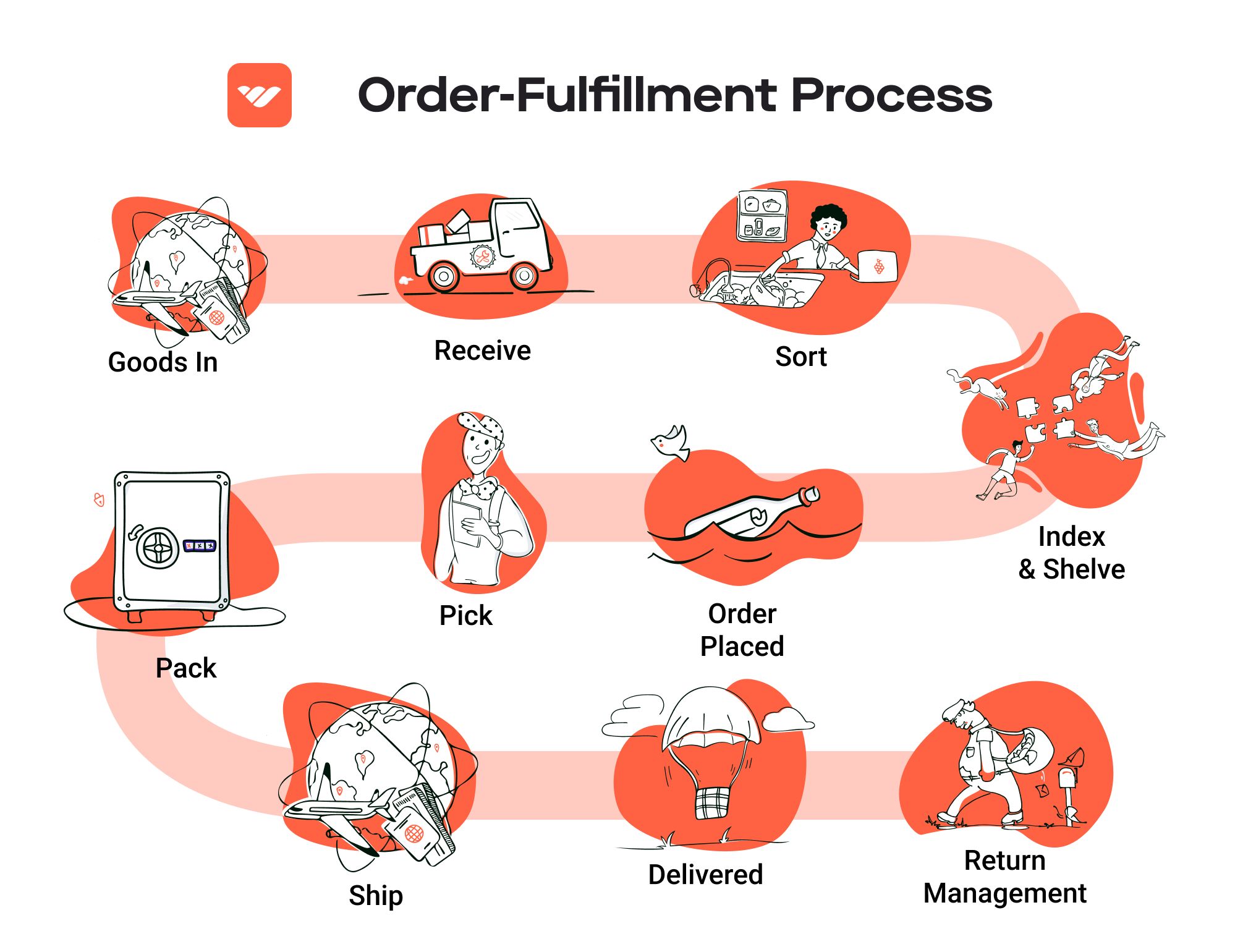
Why It’s Important: Effective packing is critical for preventing damage during transit and ensuring a positive unboxing experience for customers. Additionally, optimizing packing processes can help reduce shipping costs by minimizing package size and weight.
Key Term: Packing Slips – Documents included in the package that outline the items contained within. These slips serve as a confirmation for the customer and can also assist with returns if necessary.
5. Shipping & Delivery
The final step in the order fulfillment process is shipping and delivery. Once orders are packed, they are labeled and handed over to shipping carriers for delivery to the customer. This step involves selecting the best shipping method based on factors such as cost, speed, and destination. Real-time tracking can be provided to customers, enhancing transparency throughout the delivery process.
Why It’s Important: Timely shipping and delivery are key drivers of customer satisfaction. The ability to provide accurate tracking information can reduce anxiety for customers awaiting their orders and help build trust in your brand.
Key Term: Last-Mile Delivery – The final step of the shipping process where the package is delivered from a transportation hub to the final destination (the customer’s door). This stage can significantly influence customer satisfaction and is often the most complex and costly part of the shipping process.
By understanding and optimizing each of these five steps in the order fulfillment process, e-commerce businesses can enhance their operational efficiency, improve customer satisfaction, and ultimately drive growth as they scale.
Comparing Fulfillment Models: In-House vs. 3PL vs. Dropshipping
Fulfillment Model Comparison
| Model | Who Handles Inventory | Best For (Business Stage) | Key Advantage | Key Disadvantage |
|---|---|---|---|---|
| In-House Fulfillment | The business itself | Startups to small businesses | Greater control over processes and quality | Resource-intensive; requires space and technology |
| Third-Party Logistics (3PL) | 3PL provider | Growing businesses | Scalability and reduced operational burden | Potential loss of control over inventory and processes |
| Dropshipping | Supplier | New businesses or niche markets | Low overhead and no inventory management required | Limited control over fulfillment and customer experience |
In-House Fulfillment
In-house fulfillment involves managing the entire order processing and shipping process within your own facilities. This model is ideal for startups and small businesses that have a manageable order volume and the resources to maintain their own inventory. By handling fulfillment internally, businesses can exercise complete control over their processes, ensuring quality standards are met and providing a personalized customer experience. This control can also lead to better insights into inventory levels and product performance. However, in-house fulfillment can be resource-intensive. It requires significant investments in warehouse space, technology for inventory management, and labor for picking, packing, and shipping orders. Additionally, as order volumes grow, maintaining efficiency and consistency can become challenging, leading to potential delays and increased operational costs.
Third-Party Logistics (3PL)
Third-party logistics (3PL) involves outsourcing the order fulfillment process to a specialized provider. This model is best suited for growing businesses that need to scale their operations without the overhead of managing their own warehouse. 3PL providers handle various aspects of fulfillment, including warehousing, inventory management, picking, packing, shipping, and returns processing. The key advantage of using a 3PL is the scalability it offers; businesses can quickly adjust their fulfillment capacity in response to fluctuating demand, especially during peak seasons. This model also allows businesses to focus on core activities like marketing and product development rather than logistics. However, one of the main drawbacks of 3PL is the potential loss of control over inventory and fulfillment processes. Businesses may find it challenging to ensure that their quality standards are consistently met, which can impact customer satisfaction if not managed properly. Additionally, partnering with a 3PL typically involves various fees that can eat into profit margins.
Dropshipping
Dropshipping is a fulfillment model where the retailer does not hold any inventory. Instead, when a customer places an order, the retailer purchases the item from a third-party supplier who then ships it directly to the customer. This model is particularly attractive for new businesses or those operating in niche markets, as it requires low upfront investment and eliminates the need for inventory management. With dropshipping, businesses can offer a wide range of products without the associated risks of holding stock, making it a low-overhead option for entrepreneurs. However, dropshipping comes with its own set of challenges. The retailer has limited control over the fulfillment process, including product quality, shipping times, and packaging. This lack of control can lead to inconsistent customer experiences, which may harm the brand’s reputation. Additionally, profit margins can be thinner compared to other fulfillment models, as retailers often pay a premium for the convenience of having suppliers handle logistics.
Each fulfillment model has its own strengths and weaknesses, and the choice ultimately depends on a business’s specific needs, growth stage, and operational capabilities.
A Deep Dive into Amazon FBA: Pros, Cons, and Who It’s For
What is Fulfillment by Amazon (FBA)?
Fulfillment by Amazon (FBA) is a service provided by Amazon that allows sellers to store their products in Amazon’s fulfillment centers. When a customer places an order, Amazon takes care of storage, packaging, shipping, and customer service on behalf of the seller. This means that sellers can focus on other aspects of their business while benefiting from Amazon’s extensive logistics network and customer base.
How FBA Works
- Product Listing: Sellers create product listings on Amazon and specify that they want to use FBA.
- Inventory Shipment: Sellers send their inventory to Amazon’s fulfillment centers. Amazon provides guidelines on how to package and label products.
- Storage: Once the products arrive at the fulfillment centers, they are stored until sold.
- Order Fulfillment: When a customer places an order, Amazon picks, packs, and ships the product directly to the customer.
- Customer Service: Amazon handles all customer inquiries and returns related to the FBA products, providing a seamless experience for the buyer.
- Payment: Sellers receive payments for their sales, minus Amazon’s fees.
Pros of Using FBA
Prime Eligibility
One of the most significant advantages of FBA is that products are automatically eligible for Amazon Prime. This means that sellers can tap into a vast pool of Prime members who prefer to shop for items that offer fast and free shipping. This can lead to increased sales and visibility on the platform.
Customer Trust
Amazon is a trusted brand with a well-established reputation for customer service. By using FBA, sellers benefit from this trust. Customers are often more willing to purchase from sellers who use FBA, knowing that they can rely on Amazon for shipping and returns. This can significantly enhance a seller’s credibility.
Multi-Channel Fulfillment
FBA is not limited to Amazon sales alone. Sellers can use FBA to fulfill orders from other sales channels, such as their own websites or other marketplaces. This flexibility allows businesses to streamline their logistics and inventory management, making it easier to handle sales across multiple platforms.
Scalability
FBA allows sellers to scale their operations without the overhead of managing warehousing and logistics. As sales grow, sellers can simply send more inventory to Amazon without needing to invest in their own storage facilities or fulfillment staff.
Cons of Using FBA
High Fees
While FBA offers many benefits, it comes with a range of fees that can eat into profit margins. These include storage fees, fulfillment fees for picking and packing orders, and additional charges for long-term storage of unsold inventory. Sellers must carefully calculate these costs to ensure that their pricing strategy remains profitable.
Strict Inventory Rules
Amazon has strict guidelines regarding inventory management, including labeling, packaging, and shipping requirements. Failure to comply with these standards can result in additional fees or even the rejection of shipments. Sellers must invest time and resources to understand and adhere to these rules.
Commingling Risks
When sellers use FBA, their products may be stored alongside those of other sellers in the same fulfillment center. This commingling can lead to complications, such as receiving returns for products that were not originally sold by the seller. It can also create issues with quality control, as sellers have less oversight over how their products are handled.
Limited Control
By outsourcing fulfillment to Amazon, sellers relinquish control over the shipping process and customer experience. This can be challenging for brands that prioritize packaging, messaging, or specific shipping methods. Sellers may find it difficult to differentiate their offerings in a crowded marketplace.
Who is FBA Best For?
Fulfillment by Amazon is particularly suited for:
-
Small to Medium-Sized Businesses: Businesses looking to expand their reach without investing heavily in logistics and warehousing can benefit from FBA. It allows them to leverage Amazon’s infrastructure and customer base.
-
Brands with High Sales Volume: Sellers who can move a significant amount of inventory may find that the benefits of FBA outweigh the costs. The increased visibility and trust can lead to more sales.
-
Entrepreneurs Who Value Time: For those who prefer to focus on product development, marketing, and customer engagement rather than logistics, FBA is a viable solution. The time saved on fulfillment can be reinvested into growing the business.
-
Multi-Channel Sellers: Businesses that sell across multiple platforms can streamline their operations using FBA. This allows them to fulfill orders from various sales channels efficiently.
Conclusion
While Fulfillment by Amazon offers numerous advantages, such as Prime eligibility and customer trust, it is essential for sellers to weigh these benefits against the potential drawbacks, including high fees and strict inventory rules. Understanding these dynamics can help e-commerce business owners make informed decisions about whether FBA aligns with their growth strategies and operational needs. For many, FBA can serve as a powerful tool in scaling their businesses effectively.
Core Services Offered by Fulfillment Centers
Inventory Management & Warehousing
Inventory management and warehousing are foundational services offered by fulfillment centers that enable e-commerce businesses to maintain optimal stock levels and efficient storage solutions. This service involves the systematic tracking of inventory quantities, locations, and conditions, ensuring that products are readily available when needed.
What It Is:
Fulfillment centers utilize advanced Warehouse Management Systems (WMS) to monitor inventory levels in real-time. These systems can integrate with e-commerce platforms, automatically updating stock levels as orders are placed and fulfilled. Additionally, fulfillment centers provide physical space to store products, which can be crucial for businesses lacking adequate storage facilities.
Benefits:
1. Efficiency: By leveraging sophisticated inventory management systems, fulfillment centers reduce the risk of stockouts and overstock situations. This means that e-commerce businesses can respond swiftly to customer demand without the headaches of managing inventory manually.
-
Cost-Effectiveness: Outsourcing warehousing can save businesses significant overhead costs associated with renting or maintaining their own storage facilities. This is particularly beneficial for small to medium-sized enterprises that may not have the capital to invest in large warehouses.
-
Scalability: As businesses grow, fulfillment centers can easily scale their warehousing solutions. This flexibility allows e-commerce businesses to expand their product lines or adjust inventory levels based on seasonal demand without the need for significant capital investment.
Pick and Pack Services
Pick and pack services are critical components of the fulfillment process, where ordered items are retrieved from inventory and prepared for shipment. This service streamlines the order fulfillment process, ensuring that products are correctly selected, packed, and shipped to customers.
What It Is:
The pick and pack process involves several steps: receiving the order, picking the correct items from the warehouse, packing them into boxes with appropriate materials, and labeling the packages for shipping. Fulfillment centers typically employ trained staff and automated systems to optimize this process.
Benefits:
1. Accuracy: Fulfillment centers implement stringent quality control measures during the pick and pack process. This minimizes errors in order fulfillment, leading to higher customer satisfaction and fewer returns.
-
Speed: With specialized teams and optimized workflows, fulfillment centers can process orders rapidly. This efficiency is essential for e-commerce businesses that promise quick delivery times to their customers.
-
Cost Reduction: By outsourcing pick and pack services, businesses can reduce labor costs and minimize the need for extensive training programs. This allows companies to focus their resources on growth and customer engagement rather than logistics.
Kitting and Assembly
Kitting and assembly services are designed for e-commerce businesses that sell products requiring assembly or those that want to offer bundled products. This service allows fulfillment centers to prepare multiple items into a single kit or perform assembly tasks before shipping.
What It Is:
Kitting involves grouping different items together into one package, while assembly refers to the process of putting together components to create a finished product. Fulfillment centers can manage both processes efficiently, ensuring that kits and assembled products are ready for shipment.
Benefits:
1. Enhanced Product Offering: By providing kitting services, fulfillment centers enable businesses to offer bundled products at a competitive price. This can enhance customer satisfaction and increase average order value.
-
Time Savings: For businesses that require assembly, outsourcing this task to a fulfillment center saves time and resources. This allows companies to focus on their core competencies, such as marketing and product development.
-
Quality Control: Fulfillment centers often have established quality control processes that ensure kitted and assembled products meet specific standards before being shipped to customers. This reduces the likelihood of customer dissatisfaction due to incomplete or incorrectly assembled products.
Returns Management (Reverse Logistics)
Returns management, also known as reverse logistics, is a crucial service that addresses the challenges associated with product returns. This service ensures that returned items are processed efficiently, allowing e-commerce businesses to handle returns seamlessly.
What It Is:
Returns management encompasses the steps taken to handle returned products, including inspecting returned items, processing refunds, restocking inventory, and managing customer communications. Fulfillment centers often have dedicated teams to handle this process to maintain efficiency and customer satisfaction.
Benefits:
1. Streamlined Process: A well-structured returns management system reduces the complexity and time involved in handling returns. This is particularly important for e-commerce businesses, where returns can significantly impact profit margins.
-
Customer Satisfaction: Efficient returns management can enhance customer trust and loyalty. When customers know that they can easily return products, they are more likely to make purchases, knowing they have a safety net.
-
Data Insights: Fulfillment centers can provide valuable insights into return trends, helping businesses identify potential issues with products or customer preferences. This information can be crucial for improving product offerings and reducing future returns.
By leveraging these core services offered by fulfillment centers, e-commerce businesses can streamline their operations, enhance customer satisfaction, and scale effectively in a competitive marketplace.
How to Choose a Fulfillment Partner: A 6-Point Checklist
Location & Warehouse Network
Importance: The geographic location of your fulfillment partner’s warehouses is critical for minimizing shipping times and costs. A partner with multiple warehouses strategically placed can help you reach a wider customer base more efficiently.
Questions to Ask:
– Where are your warehouses located, and how does this affect shipping times to my key markets?
– Do you have plans for expanding your warehouse network in the future?
– What is your average shipping time to different regions?
Technology & Integrations
Importance: The technology used by your fulfillment partner can significantly impact your operational efficiency. A partner with advanced technology can streamline order processing, inventory management, and shipping logistics.
Questions to Ask:
– What fulfillment software do you use, and how does it integrate with my existing e-commerce platform?
– Can your system provide real-time inventory tracking and order updates?
– How do you handle data security and privacy in your technology?
Specializations (e.g., Cold Storage, Oversized Items)
Importance: Different products require different handling and storage conditions. If your business involves specialized products, such as perishable goods or oversized items, it is essential to ensure that your fulfillment partner has the necessary capabilities.
Questions to Ask:
– What types of products do you specialize in handling?
– Do you have the capability for temperature-controlled storage or specialized equipment for large items?
– How do you ensure compliance with industry regulations related to my product type?
Scalability & Capacity
Importance: As your business grows, your fulfillment needs will evolve. Choosing a partner that can scale with you is essential to avoid operational bottlenecks during peak seasons or rapid growth phases.
Questions to Ask:
– What is your current capacity, and how quickly can you scale operations to meet increased demand?
– How do you manage peak seasons, and what measures do you have in place to ensure timely fulfillment during these times?
– Can you provide references from businesses that have scaled with your services?
Pricing and Contracts
Importance: Understanding the pricing structure and contract terms is crucial for maintaining your profit margins. Hidden fees can quickly erode your bottom line, so transparency is vital.
Questions to Ask:
– Can you provide a detailed breakdown of your pricing structure, including setup fees, storage fees, picking and packing fees, and shipping costs?
– Are there any minimum volume requirements or long-term contracts that I should be aware of?
– How do you handle price adjustments or changes in fees over time?
Customer Support & Reviews
Importance: Reliable customer support can make or break your fulfillment experience. A partner that values communication and responsiveness can help resolve issues quickly, ensuring a smoother operation.
Questions to Ask:
– What customer support options do you offer (e.g., phone, email, chat), and what are your response times?
– Can you provide testimonials or case studies from current or past clients?
– How do you handle disputes or issues that arise during the fulfillment process?
Conclusion
Choosing the right fulfillment partner is a pivotal decision for any e-commerce business. By using this checklist to guide your selection process, you can ensure that you partner with a fulfillment provider that not only meets your current needs but also supports your growth and success in the competitive e-commerce landscape. Take the time to ask the right questions and thoroughly vet potential partners to establish a relationship that enhances your operational efficiency and customer satisfaction.
Understanding Fulfillment Pricing: A Breakdown of Common Fees
Initial Setup Fees
When partnering with a fulfillment service, the initial setup fees are often the first cost you will encounter. These fees cover the time and resources required to integrate your systems with the fulfillment provider’s technology. This may involve syncing your inventory management system, setting up your order processing workflows, and configuring the logistics software to ensure smooth operations.
Typically, initial setup fees can range from a few hundred to several thousand dollars, depending on the complexity of your requirements and the provider’s technology. Factors influencing these costs include the volume of products you plan to sell, the existing infrastructure you have in place, and any custom integrations needed for your business model. It’s crucial to clarify what services are included in these fees, as some providers may bundle additional services while others may charge extra for specific features.
Receiving Fees
Receiving fees are charged when your fulfillment partner accepts and organizes new inventory shipments. This fee covers the labor and resources involved in unloading products, inspecting them for quality, and entering them into the inventory management system.
Receiving fees can be calculated on a per-pallet basis or a per-unit basis, depending on the provider’s pricing structure. Commonly, you may find charges between $20 to $50 per pallet, or a few cents per item for smaller shipments. Keep in mind that some providers may also include additional charges for special handling or inspection of goods, particularly for fragile or high-value items. Understanding how your fulfillment partner defines “receiving” can help avoid unexpected costs.
Storage Fees (per pallet/bin)
Storage fees are incurred for the physical space your inventory occupies within the fulfillment center. These fees are typically calculated on a per-pallet or per-cubic-foot basis and are charged monthly. The cost can vary significantly based on the location of the warehouse, the demand for space, and the type of products being stored.
On average, storage fees range from $10 to $30 per pallet per month. However, for smaller items stored in bins, the fees may be calculated based on cubic footage, usually costing between $0.50 and $2.00 per cubic foot. It’s essential to consider your product turnover rate when selecting a fulfillment partner, as higher turnover may lead to lower overall storage costs. Additionally, be aware of any minimum storage requirements, as some providers may have a baseline you need to meet to avoid additional fees.
Pick & Pack Fees (per item/order)
Pick and pack fees are charged for the labor involved in retrieving items from the warehouse and preparing them for shipment. This process includes picking the correct items, packing them securely, and labeling the package for shipping.
These fees are usually calculated on a per-item or per-order basis. For example, you might encounter fees ranging from $1 to $5 per order, with additional charges for each item included in the order (often around $0.50 to $1.00 per item). The complexity of your packaging requirements can also impact these fees—custom packaging or special handling may incur additional costs. Understanding the pick and pack process of your fulfillment partner is crucial, as it can significantly affect your overall fulfillment costs.
Shipping Fees
Shipping fees cover the cost of transporting your products from the fulfillment center to your customers. These fees can vary based on the shipping method, the weight and dimensions of the package, and the destination. Most fulfillment partners work with multiple carriers, allowing you to choose the most cost-effective shipping option based on your needs.
Shipping fees are typically calculated based on real-time rates from carriers like FedEx, UPS, or USPS. It’s essential to discuss your shipping options with your fulfillment partner to understand how they calculate these fees and whether they offer discounted rates for higher volumes. Some providers might also charge a handling fee on top of the actual shipping costs, so be sure to clarify the complete breakdown of shipping charges.
Tips for Getting an Accurate Quote
-
Provide Detailed Information: When requesting quotes, offer as much detail as possible about your products, order volumes, and fulfillment needs. This helps providers give you an accurate estimate.
-
Ask About Hidden Fees: Inquire about any additional costs that may not be immediately apparent, such as minimum monthly fees, extra handling charges, or seasonal price fluctuations.
-
Compare Multiple Providers: Don’t settle for the first quote you receive. Comparing multiple fulfillment partners can help you find the best balance between cost and service quality.
-
Negotiate Terms: Many fulfillment providers are open to negotiation, especially if you can demonstrate potential for high order volumes. Discussing your needs may lead to better pricing or added services.
-
Review Contracts Carefully: Before signing an agreement, review the contract thoroughly to ensure all fees and terms are clearly outlined to avoid surprises later on.
By understanding these common fulfillment fees and how they are calculated, you can make informed decisions that align with your business goals and budget, ultimately leading to a more efficient and cost-effective fulfillment strategy.
Frequently Asked Questions (FAQs) about Fulfillment
1. What is fulfillment in e-commerce?
Fulfillment in e-commerce refers to the entire process of receiving, processing, and delivering customer orders. It encompasses everything from inventory management and order processing to shipping and returns. Effective fulfillment ensures that customers receive their orders accurately and on time, which is crucial for maintaining customer satisfaction and loyalty.
2. What’s the difference between a warehouse and a fulfillment center?
A warehouse is primarily used for storage, focusing on holding inventory until it is needed. In contrast, a fulfillment center specializes in processing and shipping orders directly to customers. Fulfillment centers are equipped with technology and systems to manage inventory, pick and pack orders, and handle returns, making them integral to the e-commerce supply chain.
3. What is a 3PL (Third-Party Logistics)?
A 3PL, or Third-Party Logistics provider, is a company that offers outsourced logistics services, including warehousing, fulfillment, and transportation. By partnering with a 3PL, e-commerce businesses can leverage their expertise and infrastructure, allowing them to scale operations without the need for significant investment in logistics capabilities.
4. How much do fulfillment services cost?
Fulfillment service costs can vary widely based on factors such as the provider, the volume of orders, and the services required. Common cost components include setup fees, storage fees (often charged per pallet or cubic foot), receiving fees, picking and packing fees, and shipping fees. It’s essential to thoroughly understand a provider’s pricing structure before signing a contract to avoid unexpected costs.
5. What are the key components of an effective fulfillment system?
An effective fulfillment system includes several key components:
– Warehousing: Storage solutions for inventory management.
– Inventory Management: Tools to track stock levels and prevent stockouts.
– Order Processing: Systems for efficiently picking, packing, and shipping orders.
– Logistics: Capabilities for managing shipping and last-mile delivery.
– Returns Management: Processes for handling returns and restocking items.
6. Should I handle fulfillment in-house or outsource it?
The decision to handle fulfillment in-house or outsource it depends on your business needs. In-house fulfillment provides greater control and can be cost-effective for smaller operations, but it requires significant resources and management. Outsourcing to a 3PL can save time and reduce operational complexity, making it a better option for businesses looking to scale quickly or those without adequate warehousing space.
7. What is dropshipping, and how does it relate to fulfillment?
Dropshipping is a fulfillment method where a retailer does not hold inventory. Instead, when a customer places an order, the retailer purchases the item from a third-party supplier, who then ships it directly to the customer. While this model minimizes overhead costs and inventory risk, it can lead to challenges with quality control, shipping times, and customer service.
8. How can technology improve fulfillment operations?
Technology enhances fulfillment operations by automating processes, improving accuracy, and providing real-time data. Systems like warehouse management software (WMS) and inventory management tools help streamline order processing, reduce errors, optimize shipping routes, and enable better tracking of inventory levels, ultimately leading to faster and more efficient fulfillment.
9. What are the common challenges in fulfillment?
Common challenges in fulfillment include managing inventory levels, ensuring timely order processing and shipping, handling returns efficiently, and maintaining customer satisfaction. Additionally, scaling fulfillment operations can be difficult during peak seasons or unexpected surges in demand, making it essential to have a flexible and responsive fulfillment strategy in place.
10. How can I choose the right fulfillment partner?
To choose the right fulfillment partner, consider factors such as scalability, technology integration, cost structure, and capabilities. Evaluate their experience in your specific industry, their ability to handle your product types, and their track record for reliability. Conduct thorough due diligence, including reading reviews and asking for references, to ensure they align with your business goals and customer service standards.
Conclusion: Is Outsourcing Fulfillment the Right Move for Your Business?
Assessing the Benefits of Outsourcing Fulfillment
Outsourcing fulfillment can be a transformative decision for e-commerce businesses seeking to scale efficiently. One of the primary advantages is the significant time savings it offers. By delegating order processing, packing, and shipping to a dedicated fulfillment partner, business owners can focus on core activities like marketing, product development, and customer engagement. This shift not only enhances productivity but also allows for a more strategic approach to business growth.
Another compelling reason to consider outsourcing is scalability. As your business experiences fluctuations in demand—whether due to seasonal trends or viral marketing—fulfillment partners can easily adjust to these changes. They have the infrastructure and resources in place to manage spikes in order volume without compromising service quality. This flexibility is essential for maintaining customer satisfaction and loyalty during peak periods.
Moreover, fulfillment services bring a wealth of expertise that many small to mid-sized businesses may lack. These providers are specialists in logistics, equipped with the latest technology and best practices that streamline the entire order fulfillment process. By leveraging their knowledge, businesses can improve operational efficiency and reduce errors, ultimately leading to a better customer experience.
However, not all fulfillment partners are created equal. It’s crucial to choose a provider that aligns with your business needs and growth ambitions. Consider factors such as technology integration, cost structure, and specific capabilities to ensure a successful partnership.
Take Action Today
To determine if outsourcing fulfillment is the right move for your business, conduct an audit of your current shipping process. Assess your operational challenges, shipping times, and customer feedback. This evaluation will provide insight into whether a fulfillment partner could enhance your logistics and support your growth trajectory. Embrace the opportunity to optimize your operations and take your e-commerce business to the next level.
Important Disclaimer
⚠️ Important Disclaimer
The information in this guide is for educational purposes. Fulfillment services, pricing, and platform features change frequently. Always conduct your own due diligence and consult with providers directly before making business decisions.
